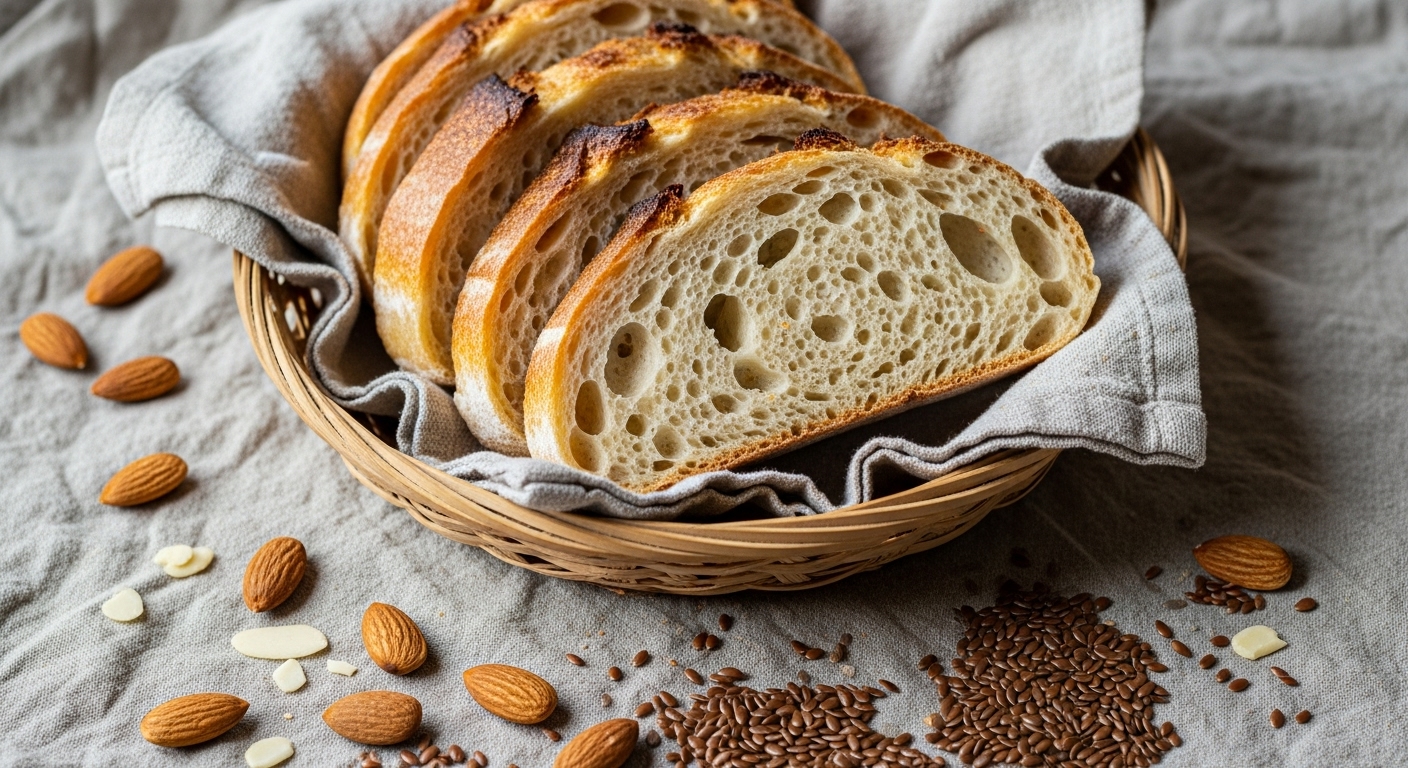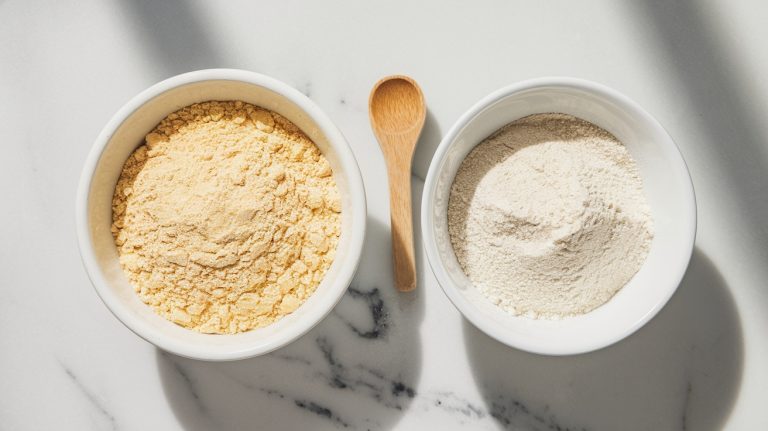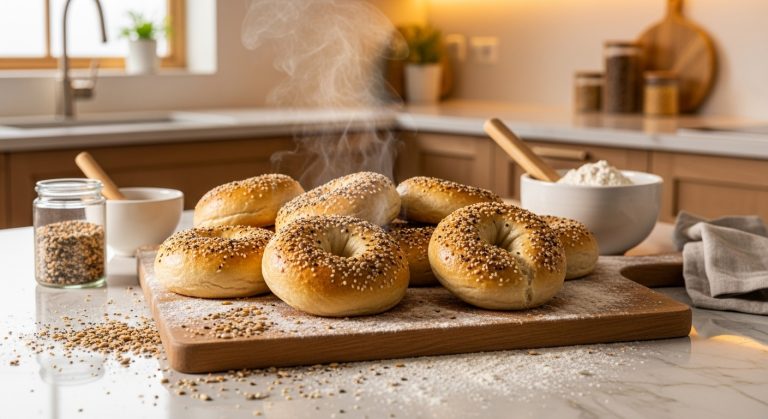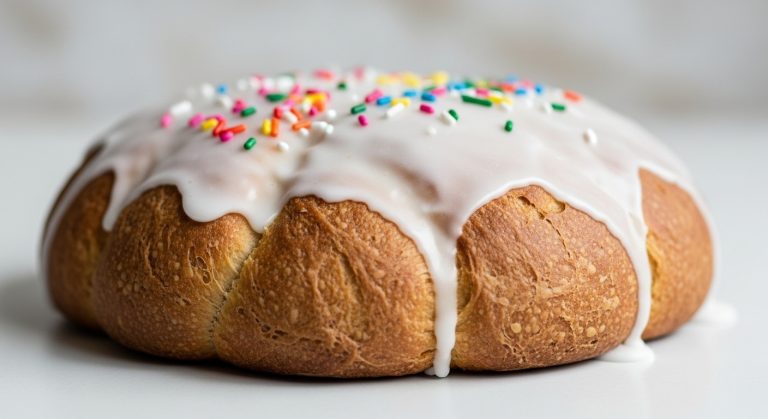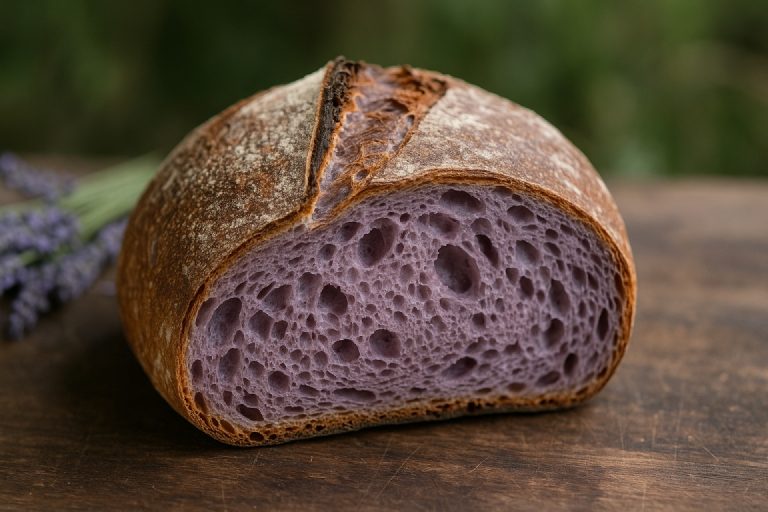Keto Sourdough Bread Recipe for Low-Carb Living
You can make keto sourdough bread by combining low-carb flours like almond and oat fiber with psyllium husk for structure and moisture. Use a sourdough starter or add vinegar and baking soda to mimic tang and leavening.
Precise mixing, proofing in a warm spot, and controlled baking guarantee a chewy texture and authentic flavor with just 3–5 grams net carbs per slice. Master these techniques for a tasty, gut-friendly loaf that fits your keto lifestyle.
Key Takeaways
- Use essential wheat gluten, flaxseed, oat fiber, and nutritional yeast for a low-carb, fiber-rich keto sourdough bread base.
- Combine egg whites, baking powder, baking soda, and psyllium husk for effective leavening and gluten-like texture without traditional yeast.
- Incorporate a mature sourdough starter or lactic acid liquid to develop authentic tangy sourdough flavor in keto bread.
- Proof dough in a warm, draft-free environment for 60–90 minutes, then bake starting at 400°F for optimal oven spring and crust.
- Cool bread completely before slicing and store properly to maintain texture, crust integrity, and flavor longevity.
Keto Sourdough Bread Recipe: Ingredients & Steps at a Glance
| Step | Ingredients / Tools | Details & Tips |
|---|---|---|
| Dry Mix | Almond flour (1 cup), Coconut flour (¼ cup), Psyllium husk (2 tbsp), Flaxseed meal (2 tbsp), Essential wheat gluten (½ cup), Baking powder (1 tsp), Baking soda (½ tsp), Salt (½ tsp) | Mix all dry ingredients thoroughly for even texture. Use a digital scale for precision. |
| Wet Mix | Egg whites (3 large), Warm water (1 cup at ~110°F), Apple cider vinegar (1 tbsp) | Whisk well to incorporate air and activate leavening. |
| Optional Flavor Boost | Nutritional yeast (1 tbsp), Lactic acid liquid (1 tsp) | Adds authentic sour tang without extra carbs. |
| Combine Dough | Dry + Wet ingredients | Mix until a thick, sticky dough forms. Adjust with small amounts of water/flour. |
| Proofing | Warm, draft-free spot | Cover and let rest for 60–90 minutes for rise and flavor development. |
| Shaping & Scoring | Dough scraper, Knife | Shape into loaf, score surface for controlled rise. Brush lightly with oil or water. |
| Baking | Preheated oven, Dutch oven (optional) | Start at 400°F for 10 min to set crust, reduce to 320°F until baked through. |
| Cooling | Wire rack | Cool completely before slicing to maintain crumb structure. |
Ingredients and Nutritional Benefits
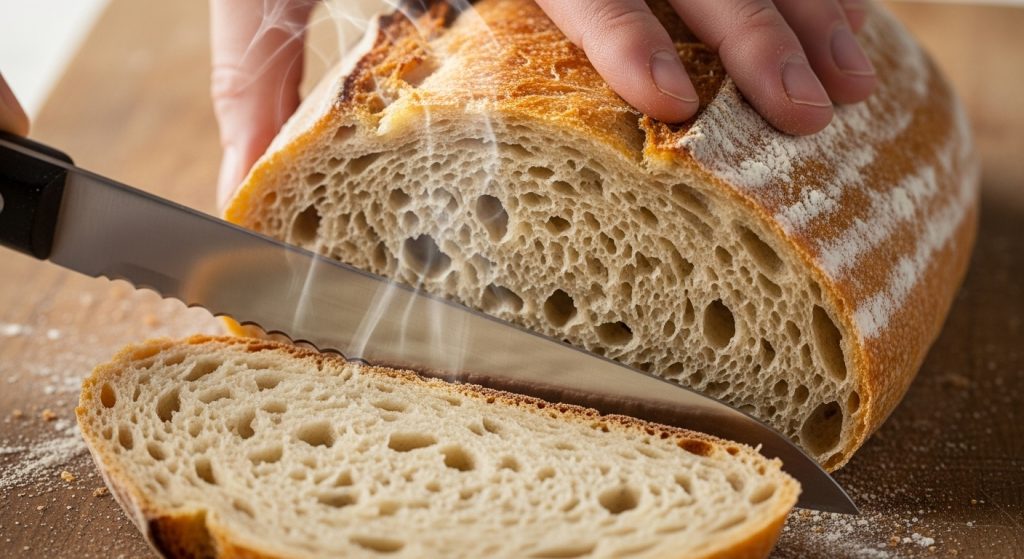
Although traditional sourdough relies on fermentation, keto sourdough bread achieves its characteristic texture and flavor by using specialized ingredients like essential wheat gluten for elasticity, flaxseed and oat fiber for fiber and moisture, and nutritional yeast combined with lactic acid to replicate the sourness without carbs.
Keto sourdough mimics traditional texture and tang using wheat gluten, flaxseed, oat fiber, and nutritional yeast.
You’ll find fundamental wheat gluten crucial for structure, while flaxseed adds omega-3s and moisture retention. Oat fiber contributes bulk without digestible carbs. Nutritional yeast provides umami flavor and B-vitamins, enhancing the bread’s profile precisely.
The recipe development involved carefully balancing these ingredients to avoid over-fermentation and achieve a true sourdough flavor without extended fermenting times, addressing a common challenge in keto baking development challenges.
This combination results in a low-carb, fiber-rich bread, typically containing 3-5 grams of net carbs per serving, and benefits from using unbromated flour alternatives to ensure natural gluten development and nutrient retention.
Additionally, the bread offers protein from gluten and nuts, healthy fats from seeds and oils, and micronutrients like magnesium, selenium, and antioxidants, supporting digestion, energy metabolism, and cardiovascular health.
Essential Techniques for Leavening and Texture
When crafting keto sourdough bread, mastering leavening and texture requires a strategic blend of ingredients and techniques that compensate for the lack of traditional gluten and commercial yeast. You’ll rely on a combination of egg whites, baking powder, and baking soda to achieve effective rise.
Psyllium husk is essential for moisture retention and structure, forming a gel that traps air and mimics gluten’s elasticity. Use warm water (~110°F) to activate natural or spiked yeast starters, ensuring proper fermentation.
Mix ingredients gently to hydrate psyllium without overworking the dough, preserving its structure. Long, controlled proofing enhances texture while avoiding overproofing prevents collapse.
Finally, balancing almond and coconut flours optimizes crumb density, producing a moist, airy bread with desirable chewiness and oven spring. Using a digital baking scale ensures precise measurement of ingredients, which is crucial for consistent keto sourdough results.
Achieving Authentic Sourdough Flavor on Keto
To achieve authentic sourdough flavor on keto, you need to focus on cultivating a balanced starter with wild yeast and lactic acid bacteria that produce the signature tang. You can mimic traditional flavors by carefully selecting low-carb flours and managing fermentation conditions to promote the right acid profiles.
Fermentation temperature plays a crucial role in developing the desired flavor and texture of your keto bread. Understanding these components lets you replicate the complex taste of sourdough while keeping carbs low.
The mature sourdough starter provides complex flavor and is essential for developing the desired tanginess in keto sourdough bread.
Sourdough Flavor Components
Since achieving authentic sourdough flavor on keto requires careful attention to multiple factors, you need to understand how flour composition, microbial diversity, and fermentation parameters interact to develop the characteristic tang and complexity.
Flour ash content influences buffering capacity, allowing bacteria to produce essential amino acids and organic acids like lactic and acetic acid, which create sourdough’s signature tang. Using flour with higher ash content increases the dough’s buffering capacity, enabling longer bacterial activity and more pronounced sourness.
Microbial diversity in wild yeasts and lactic acid bacteria generates a wide array of volatile flavor compounds, enhancing depth and authenticity. This diversity is similar to the authentic sourdough culture found in high-quality bread mixes.
Extended, cooler fermentations promote balanced acid profiles and complex flavor development.
Choosing keto-appropriate flours with sufficient mineral content supports bacterial metabolism and flavor formation.
Flavor Mimicking Techniques
Understanding how flour composition and fermentation shape sourdough’s complex flavor sets the stage for replicating that profile in keto baking without long fermentation times. You can use lactic acid liquid to impart authentic tang without unwanted vinegar notes, while nutritional yeast adds umami depth, mimicking fermentation flavors effectively.
Incorporate psyllium husk powder to improve crumb texture and moisture, enhancing flavor perception by preventing dryness typical of keto breads.
Balancing minimal sweeteners and salt sharpens flavor complexity and amplifies sourness despite reduced fermentation. Employ steam during baking with temperature ramps to develop a characteristic crunchy crust and rich aroma, essential to sourdough authenticity.
These combined techniques help you achieve an authentic keto sourdough flavor profile quickly, preserving both taste and texture. Using steam cooking technology can help maintain moisture and develop crust texture crucial for sourdough bread authenticity.
Step-by-Step Preparation and Baking Guide
Although keto sourdough bread differs from traditional recipes, you’ll still need to measure ingredients precisely, especially dry ones like almond flour, coconut flour, psyllium husk powder, and ground flaxseed, to guarantee consistent texture and flavor.
Start by combining dry ingredients thoroughly, then beat wet components separately to incorporate air. Using a kitchen scale for measurement ensures the best results and consistency in your dough preparation kitchen scale use.
Begin by mixing dry ingredients well, then whisk wet ingredients separately to add air and lightness.
Gradually mix wet into dry until you get a thick, sticky dough. Adjusting the dough with additional flour or water in small increments can help achieve the right dough consistency.
If using yeast, proof it in warm water first.
Let the dough rest covered for 60 to 90 minutes to develop flavor and slight rise, adjusting time based on dough consistency.
Shape the dough, score its surface for controlled expansion, and brush with water or oil.
Bake initially at 400°F to set the crust, then lower to 300–340°F to finish baking evenly.
Cool completely before slicing.
Variations for Dietary Preferences and Restrictions
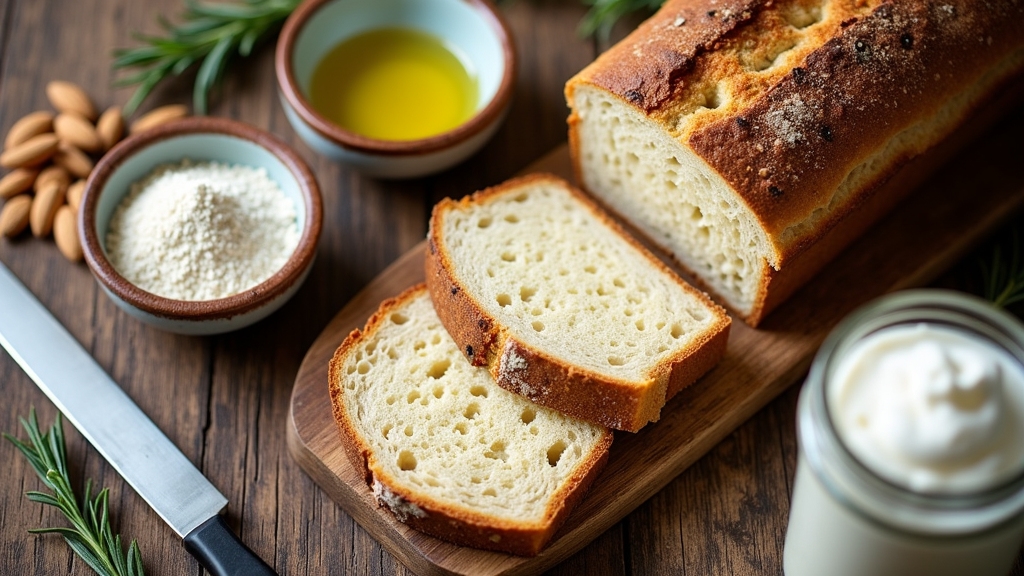
You can customize your keto sourdough bread to fit gluten-free or vegan needs by swapping traditional flours for almond, coconut, or oat fiber flours. Many low-carb breads are available that cater to keto and other dietary requirements.
For gluten-free options, rely on psyllium husk and gums to replicate gluten’s structure without adding carbs. If you follow a vegan keto diet, use flaxseed or chia seed meals as egg substitutes and consider nutritional yeast to maintain flavor while keeping carbs low. Incorporating a sourdough starter can enhance flavor and improve the bread’s texture while supporting gut health.
Gluten-Free Keto Options
When adapting keto sourdough bread for gluten-free diets, selecting the right flour alternatives plays a crucial role in achieving the desired texture and flavor. Almond flour offers moisture and a mild nutty sweetness, while coconut flour adds structure but demands moisture adjustments due to its absorbency.
The use of golden flaxseed meal helps reduce net carbs compared to other flaxseed types, making it an excellent choice for keto baking. Psyllium husk powder replaces gluten, enhancing elasticity and chewiness. Flax meal supports binding and fiber content, and zero-carb oat fiber boosts fiber without carbs.
For leavening, combine baking soda or powder with acidic liquids like apple cider vinegar to mimic sourdough tang and rise, especially when skipping yeast fermentation. Proper hydration balances coconut flour’s dryness and fiber’s absorption.
Additionally, understanding the fermentation process can help mimic traditional sourdough flavors safely without using live starters. These choices keep net carbs low, maintain protein, and ensure a chewy, flavorful gluten-free keto sourdough bread suited for strict dietary needs.
Vegan Keto Adaptations
Gluten-free keto sourdough options focus on flour substitutions to maintain texture and flavor, but vegan keto adaptations require additional ingredient strategies to replace eggs, dairy, and gluten. You’ll rely on flax or chia seeds soaked in water as egg substitutes, and plant-based milks like coconut or almond to keep moisture without adding carbs.
Incorporating whole-wheat sourdough elements in small amounts can enhance the complexity of flavor even in keto recipes.
Essential wheat gluten and oat fiber flour help replicate the structure and chewiness typical of sourdough. To capture traditional sourdough flavor without fermentation, nutritional yeast and lactic acid liquid are crucial. For vegan keto sourdough, incorporating psyllium husk is essential as it provides binding power mimicking traditional gluten structure.
Try these key vegan keto tips:
- Use aquafaba or flax meal for binding and aeration
- Incorporate psyllium husk powder to improve crumb and moisture retention
- Add vinegar or apple cider vinegar to enhance sour tang and dough rise
These adaptations ensure your vegan keto sourdough bread has both texture and flavor.
Tips for Consistency and Storage
Although keto sourdough bread relies on alternative ingredients, achieving consistent dough texture and proper rise depends largely on precise measurement and balanced components. Use a kitchen scale to weigh dry ingredients like psyllium husks and flax meal accurately, and favor egg whites to promote rise without density.
Combine coconut and almond flours for moisture and structure, and activate psyllium husks with lukewarm water for chewiness. Incorporate vinegar and baking soda to simulate sourdough leavening chemically, which is important when traditional fermentation is not used.
When shaping, oil your hands to avoid cracks and smooth the dough. Proof in a warm, draft-free area, loosely covered, to optimize rising without collapse. During rising, maintaining a warm, draft-free environment for about 90 minutes is essential to facilitate proper dough fermentation and gluten relaxation.
Using a digital kitchen thermometer can help maintain the ideal proofing temperature for best results. After baking, cool the bread fully before storing to prevent sogginess and maintain crust integrity. Proper handling ensures consistent texture and longer freshness in your keto loaf.
Frequently Asked Questions
Can I Freeze Keto Sourdough Bread for Later Use?
Yes, you can freeze keto sourdough bread for later use. Make sure it’s completely cooled—about 6 hours—to avoid sogginess.
Wrap the whole loaf tightly or freeze slices individually after flash freezing on parchment paper. Store in airtight bags, removing excess air without crushing the bread.
It stays fresh for 2 to 3 months. When ready, thaw whole loaves at room temperature or toast slices directly for the best texture and flavor.
How Long Does Keto Sourdough Bread Stay Fresh at Room Temperature?
You’d think keto sourdough bread would last forever—nope, it’s not immortal.
At room temperature, it stays fresh for about 4 to 5 days, thanks to its natural acidity and added fats slowing staling.
Keep it wrapped in a paper bag or tea towel in a cool, dry spot to avoid drying out or molding.
Skip refrigeration because it hardens bread faster than you can say “keto.”
What Kitchen Tools Are Essential for Baking Keto Sourdough Bread?
You’ll need a mixing bowl, bench scraper, and dough whisk for handling the dense dough. A kitchen scale guarantees precise measurements, essential for keto baking.
Use a Dutch oven or cast iron pot with lid to develop crust and help the bread rise. Proofing baskets or linen-lined bowls shape the dough during fermentation.
Don’t forget parchment paper, a sharp bread knife, and oven mitts for safety and ease. These tools help you bake consistently excellent keto sourdough bread.
Can I Use Regular Yeast Instead of Chemical Leaveners in This Recipe?
You can use regular yeast instead of chemical leaveners, but expect a slower rise due to yeast’s fermentation process versus the quick CO2 burst from chemicals.
Yeast not only leavens but also develops complex sour flavors vital for sourdough.
However, with keto flours low in carbs, you’ll need to manage hydration, proofing time, and temperature carefully to guarantee yeast thrives and produces the desired texture and taste in your bread.
How Do I Prevent Keto Sourdough Bread From Becoming Crumbly?
To prevent crumbly keto sourdough bread, you’ll want to balance hydration carefully—avoid too little water. Use psyllium husk powder moderately to retain moisture without making it wet. Handle dough gently to preserve gas pockets and avoid over-mixing.
Powder whole psyllium husks yourself for better texture. Also, shape the dough smoothly, apply oil to cracks, and don’t over-proof. These steps help maintain bread structure and moist crumb.
Low-Carb Loaves That Actually Taste Real
By mastering keto sourdough bread, you’re embracing a low-carb lifestyle without sacrificing flavor or texture. Did you know that switching to keto can reduce your carb intake by up to 70%, supporting better blood sugar control?
With the right techniques and ingredients, you’ll enjoy authentic sourdough’s tang and crust while keeping carbs minimal. Follow the steps carefully, and you’ll consistently bake delicious, nutritious bread that fits your dietary needs perfectly.

